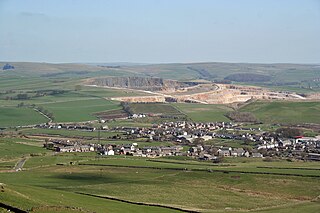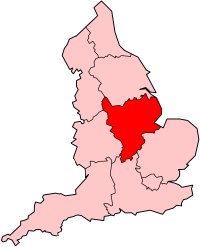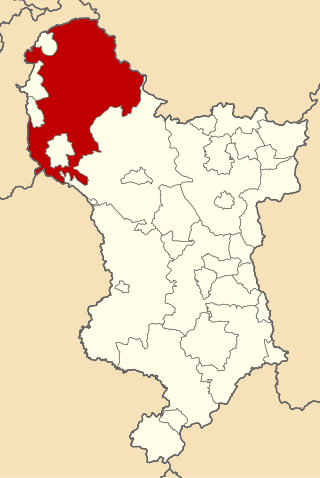
Derbyshire is a ceremonial county in the East Midlands of England. It borders Greater Manchester, West Yorkshire, and South Yorkshire to the north, Nottinghamshire to the east, Leicestershire to the south-east, Staffordshire to the south and west, and Cheshire to the west. Derby is the largest settlement, and Matlock is the county town.

Glossop is a market town in the borough of High Peak, Derbyshire, England, 15 miles (24 km) east of Manchester, 24 miles (39 km) north-west of Sheffield and 32 miles (51 km) north of Matlock. Near Derbyshire's borders with Cheshire, Greater Manchester, South Yorkshire and West Yorkshire, between 150 and 300 metres above sea level, it is bounded by the Peak District National Park to the south, east and north. In 2021, it had a population of 33,340.

High Peak is a local government district with borough status in Derbyshire, England, covering a high moorland plateau in the Dark Peak area of the Peak District National Park. The district stretches from Holme Moss in the north to Sterndale Moor in the south, and from Hague Bar in the west to Bamford in the east. The population of the borough taken at the 2011 Census was 90,892. The borough is unusual in having two administrative centres for its council, High Peak Borough Council; the offices are in Buxton and Glossop. Other towns include Chapel-en-le-Frith, Hadfield, New Mills and Whaley Bridge.

Chinley is a rural village in the High Peak Borough of Derbyshire, England, with a population of 2,796 at the 2011 Census. Most of the civil parish is within the Peak District National Park. Historically, before the coming of the railway, the area was economically dominated by agriculture. Nowadays most inhabitants commute out of the village to work; accessible centres of work include Stockport, Sheffield and Manchester.

The Night Safari, Singapore is the world's first nocturnal zoo located in Mandai, Singapore. One of the most popular tourist attractions in the country, it forms a part of the Mandai Wildlife Reserve, consisting of the Singapore Zoo, Bird Paradise and River Wonders and the upcoming Rainforest Wild Park.

Hayfield is a village and civil parish in High Peak, Derbyshire, England, with a population of around 2,700. The village is 3 miles (4.8 km) east of New Mills, 4.5 miles (7.2 km) south of Glossop and 10 miles (16 km) north of Buxton, in the basin of the River Sett.

Peak Forest is a small village and civil parish on the main road the (A623) from Chapel-en-le-Frith to Chesterfield in Derbyshire. The population of the civil parish at the 2011 census was 335.

Dove Holes is a village in the High Peak district of Derbyshire, England. It has a population of about 1,200 (2001), shown in the 2011 Census as being included in the population of Chapel-en-le-Frith. It straddles the A6 road approximately three miles north of Buxton and three miles south of Chapel-en-le-Frith. Trains run from Dove Holes railway station into Manchester.
Duffield Frith was, in medieval times, an area of Derbyshire in England, part of that bestowed upon Henry de Ferrers by King William, controlled from his seat at Duffield Castle. From 1266 it became part of the Duchy of Lancaster and from 1285 it was a Royal Forest with its own Forest Courts.

Chapel-en-le-Frith railway station serves the Peak District town of Chapel-en-le-Frith, Derbyshire, England. It is 20+1⁄2 miles south east of Manchester Piccadilly on the Buxton Line from Manchester. It was built in 1863 for the London & North Western Railway, on its line from Whaley Bridge to Buxton as an extension of the Stockport, Disley and Whaley Bridge Railway.

Combs is a small village in Derbyshire, England, in the civil parish of Chapel-en-le-Frith and the Peak District National Park.

Bowers Coaches was a bus company based in Chapel-en-le-Frith, Derbyshire, England. The company operated bus and coach services in Cheshire East, Derbyshire and Greater Manchester from 1952 until 2012. In its later years, it was a subsidiary of Centrebus and in 2012 it was merged with the Dove Holes depot of Trent Barton to form High Peak Buses.

Scouting activities can be found throughout the English region of the East Midlands. The largest number of Scouts and volunteer leaders in the region is linked to the Scout Association of the United Kingdom, while there is also a presence of traditional Scouting groups, such as the Baden-Powell Scouts' Association. The Scout Association administers the region through five Scout Counties, overseen by a regional commissioner, which largely follow the boundaries of the ceremonial counties they exist within although in Lincolnshire the former Humberside county is still used. There are also a number of Scouting clubs within Universities in the region which are affiliated to the Student Scout and Guide Organisation. Scouting organisations at every level of the hierarchy also own and operate campsites and activity centres in the area for the benefit of Scouts, Guides and other youth groups.

The New Forest Wildlife Park is located on the edge of The New Forest close to the towns of Ashurst and Lyndhurst. The park specialises in native and past-native wildlife of Britain and otters and owls from around the globe, housing four species of the former and ten of the latter.

Chapel-en-le-Frith is a town and civil parish in the Borough of High Peak in Derbyshire, England.

Chapel-en-le-Frith Central railway station was an intermediate stop on the Derby–Manchester line of the Midland Railway. It served the Derbyshire town of Chapel-en-le-Frith between 1867 and 1967.

Chapel en le Frith was a rural district in Derbyshire, England, from 1894 to 1974. It was named after the town of Chapel-en-le-Frith and created under the Local Government Act 1894.

Chinley, Buxworth and Brownside is a civil parish within the High Peak district, which is in the county of Derbyshire, England. Partially rural with several villages contained within, its population was 2,794 residents in the 2021 census. The parish is 150 miles (240 km) north west of London, 35 miles (56 km) north west of the county city of Derby, and 1+1⁄3 miles (2.1 km) north of the nearest market town of Chapel-en-le-Frith. Being close to the edge of the county border, it shares a boundary with the parishes of Chapel-en-le-Frith, Edale, Hayfield, New Mills and Whaley Bridge. A substantial portion of the parish is within the Peak District national park.
Chapel-en-le-Frith is a civil parish in the High Peak district of Derbyshire, England. The parish contains 76 listed buildings that are recorded in the National Heritage List for England. Of these, two are listed at Grade II*, the middle of the three grades, and the others are at Grade II, the lowest grade. The parish contains the town of Chapel-en-le-Frith and the surrounding area, including the smaller settlements of Dove Holes, Combs, Tunstead Milton, and Whitehough. Most of the listed buildings are houses, cottages and associated structures, farmhouses and farm buildings. The other listed buildings include churches and items in a churchyard, a market cross, public houses, two tombstones in a Friends' Burial Ground, a milestone and a milepost, bridges, a set of stocks, structures associated with the Peak Forest Tramway, schools, a mounting block incorporating a dog's kennel, a railway station, and two war memorials.

Chapel-en-le-Frith Town Hall is a municipal building in Market Street, Chapel-en-le-Frith, Derbyshire, England. The structure operates as a community events venue, as well as the offices and meeting place of Chapel-en-le-Frith Parish Council.


















